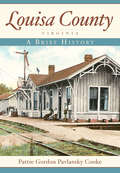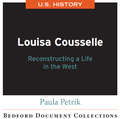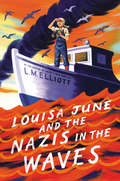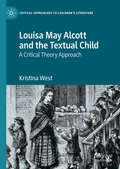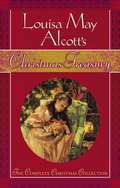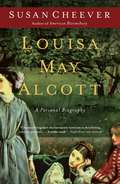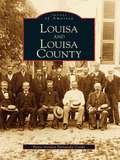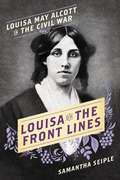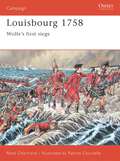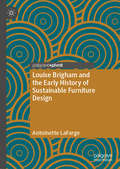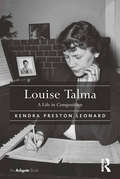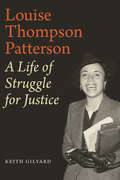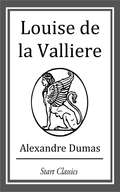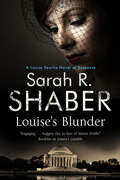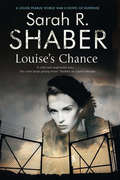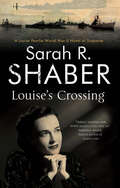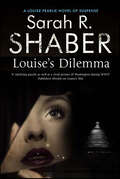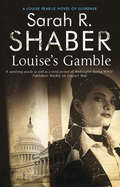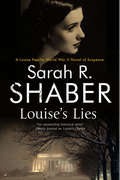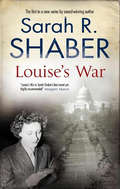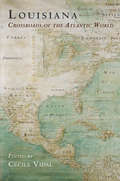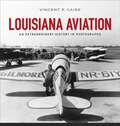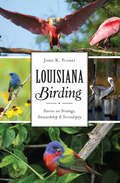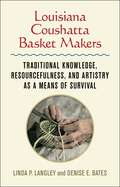- Table View
- List View
Louisa County, Virginia: A Brief History
by Pattie Gordon CookeSet amidst lush, rolling hills, Louisa County was once home to religious dissenters, emancipationists and some ofVirginia's first families. Its epicenter was Louisa Courthouse, where all the county's residents managed their business affairs. From Patrick Henry's seminal speech forLouisa against tyranny, to a county chief justice too fat to ride horseback, Louisa has a rich and fascinating heritage.Historian and longtime Louisa County resident Pattie G.P. Cooke chronicles the county's coming of age as part of the new United States of America, retaining its small, tightly knit communities while embracing inevitable progress.
Louisa Cousselle: Reconstructing a Life in the West
by Paula PetrikHistorians know that often primary source evidence is neither neat nor complete. This unit introduces you to a range of primary sources centered on the life of a nineteenth-century prostitute in the American West. Like a historian, you will use these limited sources to create a plausible account of Louisa Cousselle’s life — and, by extension, the lives of other western prostitutes. You will learn to identify evidentiary gaps and employ strategies (verification, inference, reasonable speculation) for dealing with the missing pieces.
Louisa June and the Nazis in the Waves
by L. M. ElliottIn this moving and timeless story, award-winning author L. M. Elliott captures life on the U.S. homefront during World War II, weaving a rich portrait of a family reeling from loss and the chilling yet hopeful voyage of fighting for what matters, perfect for fans of The War That Saved My Life. Days after Japan’s attack on Pearl Harbor in 1941, Hitler declared war on the U.S., unleashing U-boat submarines to attack American ships. Suddenly, the waves outside Louisa June’s farm aren’t for eel-fishing or marveling at wild swans or learning to skull her family’s boat—they’re dangerous, swarming with hidden enemies.Her oldest brothers’ ships risk coming face-to-face with U-boats. Her sister leaves home to weld Liberty Boat hulls. And then her daddy, a tugboat captain, and her dearest brother, Butler, are caught in the crossfire. Her mama has always swum in a sea of melancholy, but now she really needs Louisa June to find moments of beauty or inspiration to buoy her. Like sunshine-yellow daffodils, good books, or news accounts of daring rescues of torpedoed passengers.Determined to help her Mama and aching to combat Nazis herself, Louisa June turns to her quirky friend Emmett and the indomitable Cousin Belle, who has her own war stories—and a herd of cats—to share. In the end, after a perilous sail, Louisa June learns the greatest lifeline is love.
Louisa May Alcott and the Textual Child: A Critical Theory Approach (Critical Approaches to Children's Literature)
by Kristina WestThis book examines constructions of childhood in the works of Louisa May Alcott. While Little Women continues to gain popular and critical attention, Alcott’s wider works for children have largely been consigned to history. This book therefore investigates Alcott’s lesser-known children’s texts to reconsider critical assumptions about childhood in her works and in literature more widely. Kristina West investigates the trend towards reading Alcott’s life into her works; readings of gender and sexuality, race, disability, and class; the sentimental domestic; portrayals of Transcendentalism and American education; and adaptations of these works. Analyzing Alcott as a writer for twenty-first-century children, West considers Alcott’s place in the children’s canon and how new media and fan fiction impact readings of her works today.
Louisa May Alcott's Christmas Treasury: The Complete Christmas Collection
by Louisa May Alcott Stephen W. HinesChristmas is the season to rekindle faith, hope, and love. It is a time to enjoy friends and family, to sing carols, to give gifts. All of these joyous and evocative sentiments of the Christmas season are beautifully expressed in the life and writings of Louisa May Alcott. Now for the first time, all of Alcott's Christmas short stories and novellas--some lost to the world of publishing for nearly a century--have been gathered into a single exquisite collection, which is sure to brighten the holidays for book lovers. So slip away to a quiet nook away from the hustle and bustle of the season, cozy up with your cup of hot tea or cocoa, and prepare to have your heart warmed as you are inspired by the unforgettable characters you are about to meet in the nineteen enchanting stories of this delightful treasury.
Louisa May Alcott: A Personal Biography (Library Of America Louisa May Alcott Edition Ser. #2)
by Susan CheeverLouisa May Alcott never intended to write Little Women. She had dismissed her publisher's pleas for such a novel. Written out of necessity to support her family, the book had an astounding success that changed her life, a life which turned out very differently from that of her beloved heroine Jo March. In Louisa May Alcott, Susan Cheever, the acclaimed author of American Bloomsbury, returns to Concord, Massachusetts, to explore the life of one of its most iconic residents. Based on extensive research, journals, and correspondence, Cheever's biography chronicles all aspects of Alcott's life, from the fateful meeting of her parents to her death, just two days after that of her father. She details Bronson Alcott's stalwart educational vision, which led the Alcotts to relocate each time his progressive teaching went sour; her unsuccessful early attempts at serious literature, including Moods, which Henry James panned; her time as a Civil War nurse, when she contracted pneumonia and was treated with mercury-laden calomel, which would affect her health for the rest of her life; and her vibrant intellectual circle of writers and reformers, idealists who led the charge in support of antislavery, temperance, and women's rights. Alcott's independence defied the conventional wisdom, and her personal choices and literary legacy continue to inspire generations of women. A fan of Little Women from the age of twelve, and a distinguished author in her own right, Cheever brings a unique perspective to Louisa May Alcott's life as a woman, a daughter, and a working writer.
Louisa and Louisa County (Images of America)
by Pattie Gordon CookeFilled with local stories and anecdotes and containing an impressive range of photographs-from snapshots of veterans of the War Between the States to high school class pictures from the 1950s; from early images of the resort area to photographs documenting recent changes to Louisa-this new book will earn a lasting place on area bookshelves and will be handed down from generation to generation for years to come. Louisa and Louisa County will be enjoyed by older folk as a trip down memory lane, and appreciated by younger generations as a glimpse of an era when life was harder, but perhaps simpler. Also a valuable source of information for newcomers to the area, this powerful work serves to remind us of the importance of understanding our past and preserving our heritage in our march toward the twenty-first century.
Louisa on the Front Lines: Louisa May Alcott in the Civil War
by Samantha SeipleAn eye-opening look at Little Women author Louisa May Alcott's time as a Civil War nurse, and the far-reaching implications her service had on her writing and her activism Louisa on the Frontlines is the first narrative nonfiction book focusing on the least-known aspect of Louisa May Alcott's career - her time spent as a nurse during the Civil War. Though her service was brief, the dramatic experience was one that she considered pivotal in helping her write the beloved classic Little Women. It also deeply affected her tenuous relationship with her father, and inspired her commitment to abolitionism. Through it all, she kept a journal and wrote letters to her family and friends. These letters were published in the newspaper, and her subsequent book, Hospital Sketches spotlighted the dire conditions of the military hospitals and the suffering endured by the wounded soldiers she cared for. To this day, her work is considered a pioneering account of military nursing. Alcott's time as an Army nurse in the Civil War helped her find her authentic voice--and cemented her foundational belief system. Louisa on the Frontlines reveals the emergence of this prominent feminist and abolitionist--a woman whose life and work has inspired millions and continues to do so today,
Louisbourg 1758
by Rene Chartrand Patrice CourcelleOsprey's study of James Wolfe's siege of Louisbourg during the French and Indian War (1754-1763). Louisbourg represented a major threat to Anglo-American plans to invade Canada. Bypassing it would leave an immensely powerful enemy base astride the Anglo-American lines of communication - Louisbourg had to be taken. Faced with strong beach defences and rough weather, it took six days to land the troops, and it was only due to a stroke of daring on the part of a young brigadier named James Wolfe, who managed to turn the French beach position, that this was achieved. The story is largely based on firsthand accounts from the journals of several participants, including French Governor Drucour's, whose excellent account has never been published.
Louise Brigham and the Early History of Sustainable Furniture Design
by Antoinette LaFargeDuring the Progressive Era, a time when the field of design was dominated almost entirely by men, a largely forgotten activist and teacher named Louise Brigham became a pioneer of sustainable furniture design. With her ingenious system for building inexpensive but sturdy “box furniture” out of recycled materials, she aimed to bring good design to the urban working class. As Antoinette LaFarge shows, Brigham forged a singular career for herself that embraced working in the American and European settlement movements, publishing a book of box furniture designs, running carpentry workshops in New York, and founding a company that offered some of the earliest ready-to-assemble furniture in the United States. Her work was a resounding critique of capitalism’s waste and an assertion of new values in design—values that stand at the heart of today’s open and green design movements.
Louise Talma: A Life in Composition (Cms Monographs And Sourcebooks In American Music Ser.)
by Kendra Preston LeonardAmerican composer Louise Talma (1906-1996) was the first female winner of two back-to-back Guggenheim Awards (1946, 1947), the first American woman to have an opera premiered in Europe (1962), the first female winner of the Sibelius Award for Composition (1963), and the first woman composer elected to the American Academy and Institute of Arts and Letters (1974). This book analyses Talma’s works in the context of her life, focusing on the effects on her work of two major changes she made during her adult life: her conversion to Catholicism as an adult, under the guidance of Nadia Boulanger, and her adoption of serial compositional techniques. Employing approaches from traditional musical analysis, feminist and queer musicology, and women’s autobiographical theory to examine Talma’s body of works, comprising some eighty pieces, this is the first full-length study of this pioneering composer. Exploring Talma’s compositional language, text-setting practices, and the incorporation of autobiographical elements into her works using her own letters, sketches, and scores, as well as a number of other relevant documents, this book positions Talma’s contributions to serial and atonal music in the United States, considers her role as a woman composer during the twentieth century, and evaluates the legacy of her works and career in American music.
Louise Thompson Patterson: A Life of Struggle for Justice
by Keith GilyardBorn in 1901, Louise Thompson Patterson was a leading and transformative figure in radical African American politics. Throughout most of the twentieth century she embodied a dedicated resistance to racial, economic, and gender exploitation. In this, the first biography of Patterson, Keith Gilyard tells her compelling story, from her childhood on the West Coast, where she suffered isolation and persecution, to her participation in the Harlem Renaissance and beyond. In the 1930s and 1940s she became central, along with Paul Robeson, to the labor movement, and later, in the 1950s, she steered proto-black-feminist activities. Patterson was also crucial to the efforts in the 1970s to free political prisoners, most notably Angela Davis. In the 1980s and 1990s she continued to work as a progressive activist and public intellectual. To read her story is to witness the courage, sacrifice, vision, and discipline of someone who spent decades working to achieve justice and liberation for all.
Louise de la Valliere
by Alexandre DumasThe final volume of D'Artagnan Romances: it is usually split into four parts, The Vicomte de Bragelonne, Ten Years Later, Louise de la Valliere, and the final portion is entitled The Man in the Iron Mask.
Louise's Blunder: A 1940s Spy Thriller Set In Wartime Washington (The Louise Pearlie World War II Novels of Suspense #4)
by Sarah R. ShaberGovernment girl Louise is blackmailed into investigating the suspicious death of a missing co-worker, with sinister consequences. 1940s Washington, DC, government girl Louise Pearlie is asked to review the file usage of a missing analyst from the Office of Strategic Services—the US wartime intelligence agency—only to learn he&’d drowned in the Tidal Basin days before. OSS confirm it was an accident, and Louise is sent back to her regular job in the file rooms. Her time spent investigating Paul Hughes at least has one positive outcome, though: Louise meets a young woman in the OSS Reading Room, who asks her to join her &“salon,&” where she is encouraged to talk about controversial issues like racial segregation and equal pay for women. Socializing with the women helps her cope with her beau Joe Prager&’s transfer to New York City. But Louise&’s life soon takes a dangerous and sinister turn, and she can&’t help but worry if she&’ll wind up floating in the Tidal Basin herself . . . &“A solid and suspenseful story . . . This series keeps getting better.&” —Booklist
Louise's Chance: A 1940s Spy Thriller Set In Wartime Washington (The Louise Pearlie World War II Novels of Suspense #5)
by Sarah R. ShaberGovernment girl Louise gets her big chance, when she is tasked with recruiting German POWs for a secret mission inside Nazi Germany. 1940s Washington, DC, government girl Louise Pearlie has a new job inside the OSS—the Office of Strategic Services: recruiting German prisoners-of-war for a secret mission inside Nazi Germany. It&’s a big chance for her, and Louise hopes she can finally escape her filing and typing duties. With the job comes two new colleagues: Alice Osborne, a propaganda expert, and Merle Ellison, a forger from Texas who just happens to speak fluent German. But when the three arrive at Fort Meade camp, to interview the first German POWs to arrive there, their mission is beset by complications. Only one of the prisoners speaks English, the army officer in charge of the camp is an alcoholic and two prisoners disappeared on the ship bringing the Germans to the states. Were their deaths suicide? Officially, yes. But Louise can&’t help but have her doubts . . . &“A fine example of the historical mystery . . . The whodunit is well-crafted, with enough red herrings to keep readers guessing.&” —Star News Online &“As usual, Shaber provides interesting period details&” —Publishers Weekly
Louise's Crossing (The Louise Pearlie World War II Novels of Suspense #7)
by Sarah R. ShaberGovernment girl Louise Pearlie is thrilled to be posted to London, but her journey across the Atlantic proves to be anything but plain sailing…February, 1944. Washington D.C. With the war entering its most dangerous phase, Louise Pearlie is thrilled to be reassigned to the London office of the OSS. But in order to take up her new post, she must make a perilous crossing of the Atlantic Ocean in the SS Amelia Earhart. Accompanying her on the voyage to Liverpool are an eclectic group of passengers, including the aloof Blanche Bryant, whose husband, Eddie, died in mysterious circumstances on the ship’s voyage out to New York three months before. Most of the same crew and passengers are on the return voyage, and one question remains: was it really suicide? When the body of one of the passengers is found on deck, it’s clear that German bombs and raging storms aren’t the only threats to Louise’s safety. Can she expose a brutal killer before the ship docks in England?
Louise's Dilemma (The Louise Pearlie World War II Novels of Suspense #3)
by Sarah R. ShaberThe third book in the Louise Pearlie Mysteries is &“an entertaining combination of mystery, adventure, and romance, with a great sense of place and time&” (Historical Novel Society). Young widow Louise Pearlie seizes a chance to escape the typewriters and files of the Office of Strategic Services, the United States&’ World War II spy agency, when she&’s asked to investigate a puzzling postcard referred to OSS by the US Censor. She and FBI agent Gray Williams head off to St. Leonard, Maryland, to talk to the postcard&’s recipient, one Leroy Martin. But what seemed like a straightforward mission to Louise soon becomes complicated. Leroy and his wife, Anne, refuse to talk, but as Louise and Williams investigate, it soon becomes clear that Leroy is mixed up in something that looks a lot like treason. But what? Louise is determined to find out the truth, whatever the cost . . . &“A very good entry in this new and promising series.&” —Booklist
Louise's Gamble (The Louise Pearlie World War II Novels of Suspense #2)
by Sarah R. ShaberYoung widow Louise Pearlie becomes embroiled in a perilous game of mafia bosses, Nazi spies, and banished royalty in this wartime novel of suspense. It&’s 1942 in Washington, DC. Louise Pearlie is now a chief file clerk at the legendary Office of Strategic Services, the precursor to the CIA, and enjoying being an independent, working woman despite wartime privations. But a casual friendship struck up with Alessa di Luca, a secretive war refugee, sucks Louise into a dangerous game of mafia bosses, Nazi spies, banished royalty, and Sicilian aristocracy—placing not only her job, but her life, in jeopardy . . . &“Shaber brews a delightful mix of feminine wiles and real-life history that will keep readers turning the pages.&” —Publishers Weekly &“Shaber has created a wonderful cast of characters . . . A wonderfully entertaining read.&” —Historical Novel Society
Louise's Lies: A 1940s Spy Thriller Set In Wartime Washington D. C. (The Louise Pearlie World War II Novels of Suspense #6)
by Sarah R. Shaber&“Shaber&’s winning sixth WWII mystery is her best yet&”—from the award-winning author of Louise&’s Chance and Louise&’s Crossing (Publishers Weekly, starred review). When a body is discovered in a Washington bar, government girl Louise Pearlie is forced into a role of lies and deception. On a bitterly cold night in December 1943, Louise Pearlie and her friend Joe Prager are enjoying a quiet drink in the Baron Steuben Inn when a bloodstained body is discovered behind the bar. Although the victim had been a regular customer, no one seems to know anything about him. When it turns out there is a link to Louise&’s top-secret work at the OSS, she is ordered to find out as much as possible about the murder while keeping the connection secret from those involved, including the investigating police detective. Although Louise has been trained to keep secrets, the constant deception is taking its toll—especially when she discovers that she&’s not the only customer at the Steuben that night with something to hide. Will Louise&’s silence result in an innocent man being arrested for murder? &“[Louise&’s] sixth adventure is a worthy addition to the franchise.&”—Kirkus Reviews &“Shaber does a fine job portraying the plight of alien residents in wartime Washington, besides conveying the hectic atmosphere of a city whose resources are stretched to the limit by an influx of new workers.&”—Publishers Weekly (starred review)
Louise's War (The Louise Pearlie World War II Novels of Suspense #1)
by Sarah R. ShaberThe first book in the Louise Pearlie Mysteries is &“Sarah Shaber&’s best novel yet&” (Margaret Maron). It&’s 1942. Louise Pearlie, a young widow, has come to Washington, DC to work for the legendary Office of Strategic Services, the precursor to the CIA. When she discovers a document concerning the husband of her college friend Rachel Bloch—a young French Jewish woman she is desperately worried about—Louise realizes she may be able to help Rachel escape from Vichy France. But then a colleague whose help Louise has enlisted is murdered, and she realizes she is on her own, unable to trust anyone . . . &“A satisfying puzzle as well as a vivid picture of Washington during WWII.&” —Publishers Weekly &“An auspicious debut.&” —Library Journal
Louisiana
by Cecile VidalLocated at the junction of North America and the Caribbean, the vast territory of colonial Louisiana provides a paradigmatic case study for an Atlantic studies approach. One of the largest North American colonies and one of the last to be founded, Louisiana was governed by a succession of sovereignties, with parts ruled at various times by France, Spain, Britain, and finally the United States. But just as these shifting imperial connections shaped the territory's culture, Louisiana's peculiar geography and history also yielded a distinctive colonization pattern that reflected a synthesis of continent and island societies.Louisiana: Crossroads of the Atlantic World offers an exceptional collaboration among American, Canadian, and European historians who explore colonial and antebellum Louisiana's relations with the rest of the Atlantic world. Studying the legacy of each period of Louisiana history over the longue durée, the essays create a larger picture of the ways early settlements influenced Louisiana society and how the changes of sovereignty and other circulations gave rise to a multiethnic society. Contributors examine the workings of empires through the examples of slave laws, administrative careers or on-the-ground political negotiations, cultural exchanges among masters, non-slave holders, and slaves, and the construction of race through sexuality, marriage and household formation. As a whole, the volume makes the compelling argument that one cannot write Louisiana history without adopting an Atlantic perspective, or Atlantic history without referring to Louisiana.Contributors: Guillaume Aubert, Emily Clark, Alexandre Dubé, Sylvia R. Frey, Sylvia L. Hilton, Jean-Pierre Le Glaunec, Cécile Vidal, Sophie White, Mary Williams.
Louisiana Aviation: An Extraordinary History in Photographs
by Vincent P. CaireAt the beginning of the twentieth century the skies presented a new frontier, one that attracted daredevils, businessmen, politicians, and engineers enticed by a new form of transportation. Louisiana entrepreneurs and pilots proved instrumental in ushering in the Golden Age of Aviation. They advanced aircraft design, revolutionized aerial crop dusting, pioneered airmail routes, pushed the limits of stunt flying, and entertained spectators with air races. A pilot and freelance writer with more than twenty years of experience in the aviation industry, Vincent P. Caire chronicles the state's history of flight in 196 vintage and contemporary photographs, many never-before published. Photos of early aviation pioneer John Moisant, air racing champion General James Doolittle, barnstormer Roscoe Turner, aircraft designer James Wedell, and founder of Delta Airlines C. E. Woolman reflect Louisiana's zeal for aeronautics. Caire explains how the efforts of Senator Huey P. Long and Harry P. Williams, co-owner of the Wedell-Williams Air Service in Patterson, Louisiana, influenced the development of viable airmail routes throughout the southeastern United States. Rarely seen photographs depict the Art Deco elegance of the first modern, multioperational passenger terminal in the nation -- Shushan Airport in New Orleans.A captivating visual tour spanning one hundred years, Louisiana Aviation celebrates the state's air history, evident in Louisiana's seventy airports, 5,000 aircraft, 7,000 pilots, and numerous airshows in operation today.
Louisiana Birding: Stories on Strategy, Stewardship & Serendipity (Natural History)
by John K. FloresFrom the bayous of the coast to prairies and rolling hills, Louisiana is home to a vibrant and thriving avian population. Herons, American goldfinches, snow geese and more call the state coastline home during the winter months. The music of neotropic songbirds like the parula and the prothonotary warbler fills the bayous every spring morning. Endangered species like the whooping crane and brown pelican have been reintroduced to the state to great success. The pragmatic conservation efforts of state, federal and private agencies not only led to the successful delisting of some endangered species of birds but also helped develop protocols for the future stewardship of others. Award-winning outdoor writer and photographer John Flores celebrates Louisiana's notable feathered inhabitants in their natural habitats.
Louisiana Coushatta Basket Makers: Traditional Knowledge, Resourcefulness, and Artistry as a Means of Survival
by Denise E. Bates Linda LangleyLouisiana Coushatta Basket Makers brings together oral histories, tribal records, archival materials, and archaeological evidence to explore the fascinating history of the Coushatta Tribe’s famed basket weavers. After settling at their present location near the town of Elton, Louisiana, in the 1880s, the Coushatta (Koasati) tribe developed a basket industry that bolstered the local tribal economy and became the basis for generating tourism and political mobilization. The baskets represented a material culture that distinguished the Coushattas as Indigenous people within an ethnically and racially diverse region. Tribal leaders serving as diplomats also used baskets as strategic gifts as they built political and economic allegiances throughout the twentieth century, thereby securing the Coushattas’ future.Behind all these efforts were the basket makers themselves. Although a few Coushatta men assisted in the production of baskets, it was mostly women who put in the long hours to gather and process the materials, then skillfully stitch them together to produce treasures of all shapes and sizes. The art of basket making exists within a broader framework of Coushatta traditional teachings and educational practices that have persisted to the present.As they tell the story of Coushatta basket makers, Linda P. Langley and Denise E. Batesprovide a better understanding of the tribe’s culture and values. The weavers’ own “language of baskets” shapes this narrative, which depicts how the tribe survived repeated hardships as weavers responded on their own terms to market demands. The work of Coushatta basket makers represents the perseverance of traditional knowledge in the form of unique and carefully crafted fine art that continues to garner greater recognition and appreciation with every successive generation.
